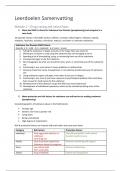Samenvatting
Summary Addiction & Compulsive disorders exam 1
This summary is based on the learning objectives and contains college notes, slides & the literature. The subjects are: drug craving & neural basis, drug habits, cognitive control & neural basis, cognitive behavioral treatment of substance abuse, comorbidity & the role of family and friends and cog...
[Meer zien]




